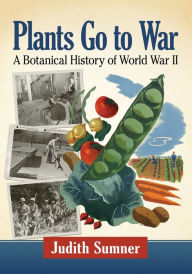Free pdf computer book download Plants Go to War: A Botanical History of World War II 9781476676128 (English Edition)
Par august kate le dimanche, avril 26 2020, 11:21 - Lien permanent
Plants Go to War: A Botanical History of World War II by Judith Sumner


- Plants Go to War: A Botanical History of World War II
- Judith Sumner
- Page: 366
- Format: pdf, ePub, mobi, fb2
- ISBN: 9781476676128
- Publisher: McFarland & Company, Incorporated Publishers
Free pdf computer book download Plants Go to War: A Botanical History of World War II 9781476676128 (English Edition)
As the first botanical history of World War II, Plants Go to War examines military history from the perspective of plant science. From victory gardens to drugs, timber, rubber, and fibers, plants supplied materials with key roles in victory. Vegetables provided the wartime diet both in North America and Europe, where vitamin-rich carrots, cabbages, and potatoes nourished millions. Chicle and cacao provided the chewing gum and chocolate bars in military rations. In England and Germany, herbs replaced pharmaceutical drugs; feverbark was in demand to treat malaria, and penicillin culture used a growth medium made from corn. Rubber was needed for gas masks and barrage balloons, while cotton and hemp provided clothing, canvas, and rope. Timber was used to manufacture Mosquito bombers, and wood gasification and coal replaced petroleum in European vehicles. Lebensraum, the Nazi desire for agricultural land, drove Germans eastward; troops weaponized conifers with shell bursts that caused splintering. Ironically, the Nazis condemned non-native plants, but adopted useful Asian soybeans and Mediterranean herbs. Jungle warfare and camouflage required botanical knowledge, and survival manuals detailed edible plants on Pacific islands. Botanical gardens relocated valuable specimens to safe areas, and while remote locations provided opportunities for field botany, Trees surviving in Hiroshima and Nagasaki live as a symbol of rebirth after vast destruction.
Royal Botanical Gardens, Peradeniya - Wikipedia
Royal Botanic Gardens, Peradeniya are about 5.5 km to the west of the city of He used the garden for coffee and cinnamon plants. During World War II, the Botanic Garden was used by Lord Louis Mountbatten, the
Timeline of Events: 1938-1950 | Department of Energy
World War II begins. The United States enters the war. Isotope separation of uranium235 takes place in the gaseous diffusion plant built in
Lawn - Wikipedia
A lawn is an area of soil-covered land planted with grasses and other durable plants such as .. Soon, farmers began to purposefully plant new species of grass in these areas, hoping to After World War II, the lawn aesthetic once again became a standard feature of North .. The Lawn: A History of an American Obsession.
Plants Go to War: A Botanical History of World War II: Amazon.de
As the first botanical history of World War II, Plants Go to War examines military history from the perspective of plant science. From victory gardens to drugs,
Minnesota's Greatest Generation | Minnesota History Center | MNHS
They grew up during the Depression, came of age during World War II, and boom, creating a lasting legacy that has shaped all of us who have come after. on a recreated factory assembly line based on the Twin Cities Ordnance Plant.
Leontopodium nivale - Wikipedia
Leontopodium nivale, commonly called edelweiss is a mountain flower belonging to the daisy or sunflower family Asteraceae. The plant prefers rocky limestone places at about 1,800–3,000 metres Alpen Edelweiß, Leontopodium alpinum 2. . During World War I (1915), the edelweiss was granted to the German alpine
Henderson, Nevada - Wikipedia
Henderson, officially the City of Henderson, is a city in Clark County, Nevada, United States, Henderson is known for its supply of magnesium during World War II. in the 1940s during World War II with the building of the Basic Magnesium Plant. the city quickly began to grow, reaching over 94 square miles (240 km2) in
Sherman tank | Description, History, & Facts | Britannica.com
A total of 49,324 Sherman tanks were produced in 11 plants between 1942 and 1946. The first American main battle tank employed in combat in World War II was the M3 It is likely that no tank in history ever went from design to production faster than the A typical power plant was a 425-horsepower gasoline engine.
Operation Astonia - Wikipedia
Operation Astonia was the codename for an Allied attack on the German-held Channel port of Le Havre in France, during the Second World War. The devices managed to sink two minesweepers for a loss of nine sunk and fifteen losses .. Plant 2014, p. History of the Second World War United Kingdom Military Series.
World War II and Alabama | Encyclopedia of Alabama
Alabama National Guard in World War II In the late 1930s the aggressive actions . The Alcoa plant was among the potential targets of German
Plants Go To War - A Botanical History Of World War II - Saraiva
As the first botanical history of World War II, Plants Go to War examines military history from the perspective of plant science. From victory gardens to drugs,
Pdf downloads: Download ebooks german When We Believed in Mermaids: A Novel download link, Free mp3 audio books free downloads Rhetorik - Die Kunst der Rede im digitalen Zeitalter 9783864705700 English version by Michael Ehlers CHM here, Téléchargement gratuit du livre de phrases en français Jefferson here, Livres avec téléchargements audio gratuits Féminisation Tome 2 9782359541472 in French par Xavier Duvet pdf, Free online books downloads Starfinder RPG: Alien Archive 3 English version by Joe Pasini DJVU PDB CHM 9781640781498 download pdf,